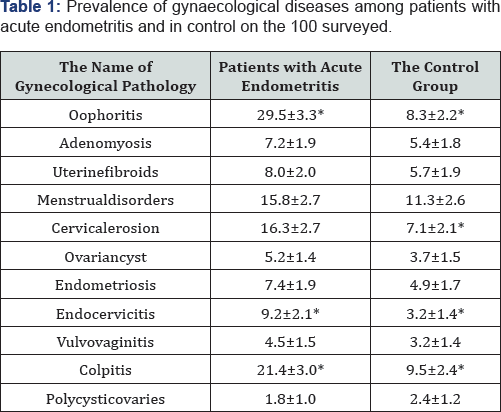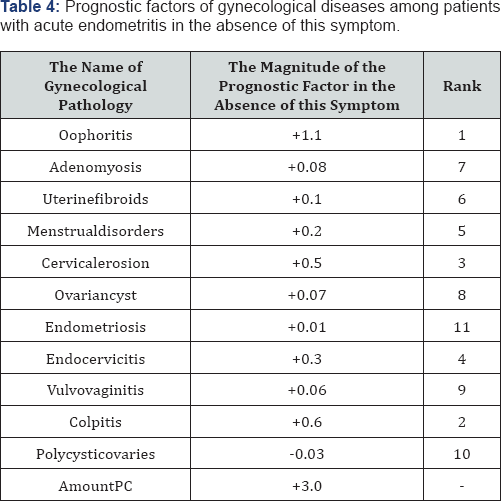Juniper Publishers : Prognostic Significance of Gynecological Diseases in the Development of Acute Endo-Dimertitis
JUNIPER PUBLISHERS- JOURNAL OF GYNECOLOGY AND WOMEN’S HEALTH
Journal of Gynecology and Women’s Health-Juniper Publishers
Authored by Agarkov NM*
Introduction
In the General population of women of reproductive age there is a General increase in the frequency of acute salpingoophoritis and endometritis [1-5]. Moreover, there seems to reduce the prevalence of acute endometritis after childbirth, abortion, and especially after cesarean section, despite the subject of numerous studies [5]. The frequency of puerperal endometritis in a population is 3-8%, pathological childbirth is 10-20%, and in women with high infection risk - 13, 3-54, 3% [2,3,6]. Alarming is the fact that along with the increase in the number of patients with acute inflammatory diseases of the female genital organs, there is growth in young population [4].
Material and Methods
In accordance with the purpose of the study was carried out a survey of 154 patients with acute post-partum endometritis (main group) and 103 patients with uncomplicated postnatal period (control group).
Prognostic factors risk factors for development of acute endometritis was calculated by the formula:

Where,
PF- the prognostic factor of risk factors in its presence and absence,
P1 - the frequency of the risk factor in control group,
P2 - the frequency of occurrence of this risk factor in the main group.
Results
Prevalence of gynecological diseases in patients with acute endometritis on the 100 women surveyed is low (Table 1).Significantly more often in the main group and towards the control found oophoritis. The disease is reported almost every third surveyed. Among patients of the main group noted the predominance of cervical erosion, endocervicitis and vaginitis. This pathology has significant differences in comparison with similar indicators of control group. Especially varies considerably, the frequency of obesity, the level of which is high enough. However, other researched gynecological diseases not only rarely circulated, but have no statistically significant difference. Low rates among gynecological pathology in patients with acute endometritis accounts for the incidence of polycystic ovaries, vulvovaginitis. Frequency of menstrual cycle disorders, although significant, but the difference in comparable groups is not representative.

Gynecological diseases registered in patients with acute endometritis, are generally significant information on the group risk factors (Table 2). It is written primarily relates to the incidence of oophoritis, which occupies the largest of informative ness Kullback first rank position, and which comprises almost half the total information content. This mathematical criterion is significant for the incidence of vaginitis, cervical erosion, endocervicitis. The measure of informative ness for other forms of gynecological pathology in patients with acute endometritis was low. So, for uterine fibroids and menstrual disorders the measure of informativity varies from 1.7 to 3.2, which indicates the dubiousness of these diseases as risk factors for development of acute endometritis. Even lower values of informativeness set for adenomyosis, ovarian cysts, vulvovaginitis, and polycystic ovaries.


The calculation of prognostic factors of gynecological diseases in patients with acute endometritis showed that they must be considered when performing individual forecasting required disease, since many diseases have significant negative values (Table 3). The maximum value of the prognostic factor in the presence of risk factors account for the incidence of patients with salpingoophoritis, won first place. Close value of predictability to the previously named diseases is the presence of endocervicitis, which corresponds to a second rank position. Practical, equal and significant values of the prognostic factor with a negative sign characteristic of cervical erosion and colpitis, being at the same time on the third and fourth position. Then there are other nosological forms of gynecological diseases, the predictability of which below, but with a negative sign. The positive sign of the prognostic factor was observed only for the presence of polycystic ovaries in patients with acute endometritis.

Significantly changed the direction and magnitude of predictive value of gynecological diseases in patients with acute endometritis in the absence of these risk factors (Table 4). First, the magnitude of the predictive coefficients decreased markedly. Second, because of this significantly decreased the amount of prognostic significance in gynecological pathology for the prediction of acute endometritis. Thirdly, almost all gynecological diseases acquired positive sign that suggests that in the absence of these risk factors for the development of acute endometritis is unlikely. Fourth, changed rank positions of individual gynecological diseases. However, salpingo remains the most predictive risk factor and occupies the first position in patients with acute endometritis. Second place belongs to the incidence of Women's obesity, the predictive coefficient which is the same rate of salpingoophoritis. Remained unchanged rank position for the predictive value of cervical erosion (third place). Extremely low values of prognostic factors among patients with acute endometritis is characteristic of endometriosis and polycystic ovaries.
For more open access journals in JuniperPublishers please click on: https://juniperpublishers.com/
For more articles on Gynecology and Women’s Health please click on: https://juniperpublishers.com/jgwh/
To read more......Fulltext in Gynecology and Women’s Health in Juniper Publishers




Comments
Post a Comment